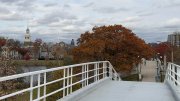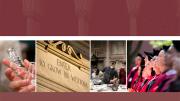Most bluntly, the question was, "What are you?" Usually posed by a defiant, cocked-hip, sandy-haired child on the local monkey bars, the strange question usually left me frozen in my Strawberry-Shortcake Tretorns. What I realized over time was that even the most brutal taunter had brought up a valid point--there wasn't anybody around who looked like me. I had no brothers or sisters, and my parents didn't look like each other, or exactly like me--Mommy was Filipino, Daddy was Indian, I was both. But I had learned in my first five years that what I looked like didn't matter to my parents and friends, those people who knew me best and loved me most. I dismissed the jibes from my young head in favor of more intriguing occupations, such as making the bathtub overflow and conducting scientific experiments with saltines.
But five grows up fast. When The Driver's License arrived, I embraced my new-found mobility and freedom to take joyrides into Chicago from the 'burbs. But a new wave of ethnic insecurity washed over me as I fielded more questions about my skin color and appearance--although this time phrased with more complexity than "What are you?" As I waited in line at the McDonald's on State Street (what adventurers we were!), patrons would turn to me and spin off inquiries in a variety of foreign languages--I could identify only Spanish. What bothered me about these incidents was not the recurring queries, but the shadow of disappointment that passed over the stranger's face as I stared blankly, and then fashioned a wan smile. "I don't understand," I would murmur apologetically. I simply could not make a connection.
Slowly, I began to feel as if I were barred from a secret society of lucky, ethnically self-aware individuals. It was not that I had been pushed out or excluded, but that I hadn't yet been given the key that would allow my inclusion and participation. Since childhood, my ethnic halves had cancelled one another out. Given the circumstances of my dual heritage and all-American upbringing, how was I to burrow my way into a cultural identity?
When college applications began to slide into rusty mailboxes all over town, I felt more attacked than just uneasy. The wall I had put up against this looming ethnicity question crumbled as I prepared to leave the nest. "Diversity" became the catch-word for college shopping and choosing. But when I did the college tour and sampled the self-championed "diverse" campus, I noticed that the melting pot of colorful individuals had transformed itself into several homogeneous enclaves. The beautiful Indian woman with whom I coincidentally stayed as a "pre-frosh" introduced me only to other Indian students. So my ethnic background, which had previously been meaningful only to others, was suddenly supposed to define my actions, in a sort of elaborate ritual resembling the cruel antics I had witnessed on the playground as a child: that terrifying practice known as "choosing teams." Years later, almost in college, I felt obligated to revert to these teams once again: to use my own ethnicity--and other people's--to inform decisions about college and friends.
Then there was the not-so-diverse campus. Small, liberal-arts, sandy heads (uh-oh...), and blue eyes, thriving in a New England paradise. Yet I loved the school and had a wonderful time, despite its lacking a rainbow of student ethnicity. Back home, prepared for a few Asian friends to reprimand me about my insights, all I could say was, "Maybe it's not so diverse now. But if I go to school there, I add diversity." They thought I was crazy, probably because they assumed that my commitment to infiltrating the ranks of uniform campuses was driven by my desire to be the exotic one. At the time, however, I thought that I had fashioned the best compromise between what I wanted, and what people thought I should want. If everyone needed diversity, I could give them diversity, but I could still attend a college where I felt happy and comfortable.
I thought I was doing everything right by deciding on Harvard, but diversity never entered my mind when I finally got that acceptance letter. It was Harvard. The Old Yard. Rowing on the Charles. JFK in my freshman-year dorm room. Yet alongside the tradition that emanated from every stone on campus, I realized that a great number of fellow minority students had incorporated ethnic and cultural activities into their lives, in ways both admirable and alluring to me. They learned traditional ethnic dances, held food festivals, participated in debates on race and politics, and brought cultures from all over the world to the Harvard community.
Although I reveled in singing on stage, writing and editing for publications, and tutoring students on campus, I felt irresponsible in light of my college-mates' enthusiasm for and expertise in ethnicity. I had not done enough to learn about my cultural heritage, let alone to foster practical diversity at Harvard. Admittedly, since I had not been in touch with my Filipino or Indian background at home or during high school, it never seemed natural to join the Harvard Philippine Forum or the South Asian Association. Yet I still felt a kind of longing, as if I had missed out on an experience that nothing after college could replicate.
To address the questions that had sporadically unsettled my perception of myself, particularly since my arrival in Cambridge, I turned to some classmates whose involvement with ethnic groups at Harvard has fallen at the opposite extreme. Paula Fernandez '99 of Pforzheimer House and Tenafly, New Jersey, became involved with the Harvard Philippine Forum (HPF) and the Asian American Association (AAA) when she first stepped on campus freshman year. She eventually served as president of HPF and coedited the Asian-American Student Handbook, a guide to Asian-American resources at Harvard and in Cambridge and Boston. She considers advocacy and activism to be the most effective means to discover cultural identity through ethnic organizations. "Although my high school was diverse and somewhat liberal," she says, "I also found that it was occasionally racist, so I decided to become involved with the political angle of ethnic groups when I came to Harvard. While I learn and grow through educational and cultural activities, there are wrongs in society that should be changed, and this is when political work becomes vital. Even though an organization as small as HPF usually focuses on the specific needs of the Filipino community, AAA has the additional resources to cooperate with other ethnic groups to bring Asian-American and minority issues to a larger audience."
Paula's work to combat minority discrimination gave her the unique opportunity to learn about her Filipino heritage while devoting herself to larger political causes. But another classmate pointed out a specially personal advantage of finding ethnic identity at Harvard. "A lot of my family from India live near my home, so I experienced my culture all the time," says Sharmil Modi '99 of Leverett House and Cleveland, who has served as co-president of the South Asian Association (SAA) and as a steering committee member of AAA. "When I came to Harvard, the opportunity to meet people who had been brought up the same way that I had, with many of the same values, was extremely important to me." For Sharmil, even though cultural, educational, and political work were all valuable reasons to join ethnic groups, it was the personal warmth he felt from their members that compelled him to remain involved in SAA and AAA. "I developed the social and emotional support network that launched my freshman year," he points out, "and I was happier at Harvard because of it."
I don't intend to relieve myself of responsibility in this matter of ethnic identity, and I haven't exempted myself from its every angle. After reading James Baldwin's The Fire Next Time, I took a couple of classes in the Afro-American studies department--and I had found something. Although it was limited to literary and historical studies, I experienced a glow of intellectual fire that I had expected to find soon after beginning classes at Harvard. But even though I am fascinated by the study of a particular minority group, it isn't my group. Questions about inauthenticity and irresponsibility still weigh on me, and haven't been fully answered by my work on this article.
But I do have the opportunity--not as a minority student, but as a Harvard student--to confront racism and promote diversity while I remain at the College. I am inspired by President Rudenstine's statement that "[Diversity] represents now, as it has since the mid-nineteenth century, positive educational values that are fundamental to the basic mission of colleges and universities. [Diversity] is also extremely important to the development of civic virtues--and of future leaders--vital to the health and effective functioning of our democracy." These ideas do not have to limit themselves to students of color, whatever that color may be. Such visions are color-less, and can be the collective vision of the world community.
And perhaps, this is where I may find my place among the objectives and concerns of ethnic organizations on campus, whether formally or informally, through direct membership or ideological support. Whether or not I form a direct link with the Harvard Philippine Forum, the South Asian Association, or the Half Asian People's Association, I can still be connected to the work these groups do. I don't have to feel Indian or Filipino to be involved with the services these organizations provide, which is why I understand why ethnic groups use their solidarity to "recruit"--alongside a cappella groups and the Harvard Crimson--during freshman registration. Like any other student group, ethnic organizations may benefit from the vast range of individuals newly entering Harvard Yard--the fire and conviction of a veteran activist, the grace of a future Gunghroo dancer, or the unspent enthusiasm of a newcomer to the ethnic scene.
I cannot promise that I will be that newcomer. While Paula and Sharmil have used ethnic organizations as a means to self-exploration or service to the community, I have simply grown and given in different ways, pursued other directions. But my ambiguous ethnic identity has not prevented me from experiencing diversity at Harvard. I learned what it was like to grow up with brothers and sisters. I learned what it was like to wear uniforms to school, or to be a real cheerleader, or to win a national competition with a speech about being short. I've listened to stories about health clinics in Kenya, church work in the Dominican Republic, and Hebrew school in Israel. I discovered that maybe Maine is "the way life should be," but that there's something about the California waves that beckons you back to the surf. And I, in turn, have told you about my encounters on the monkey bars.








